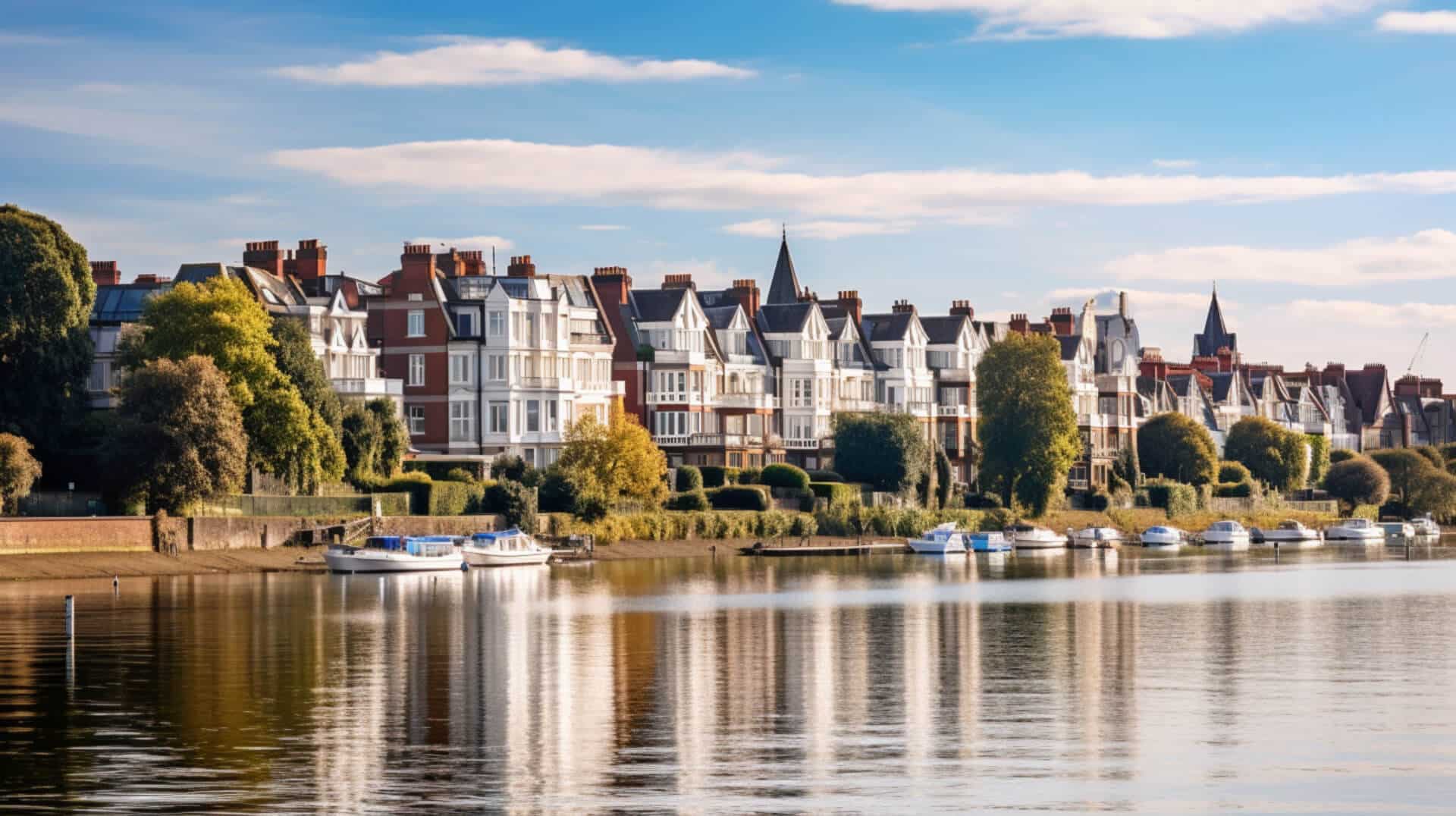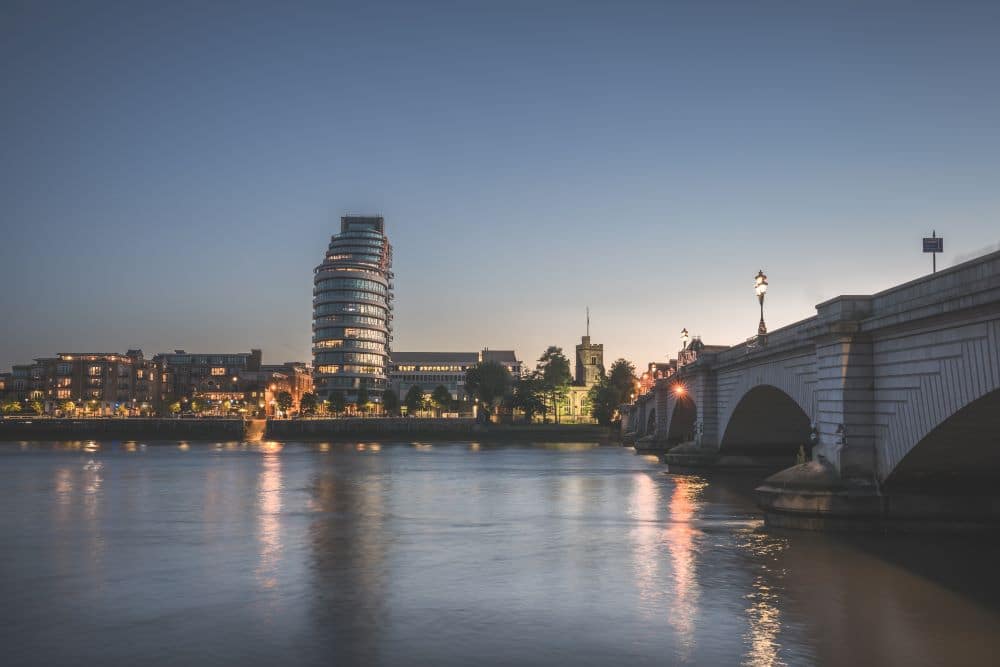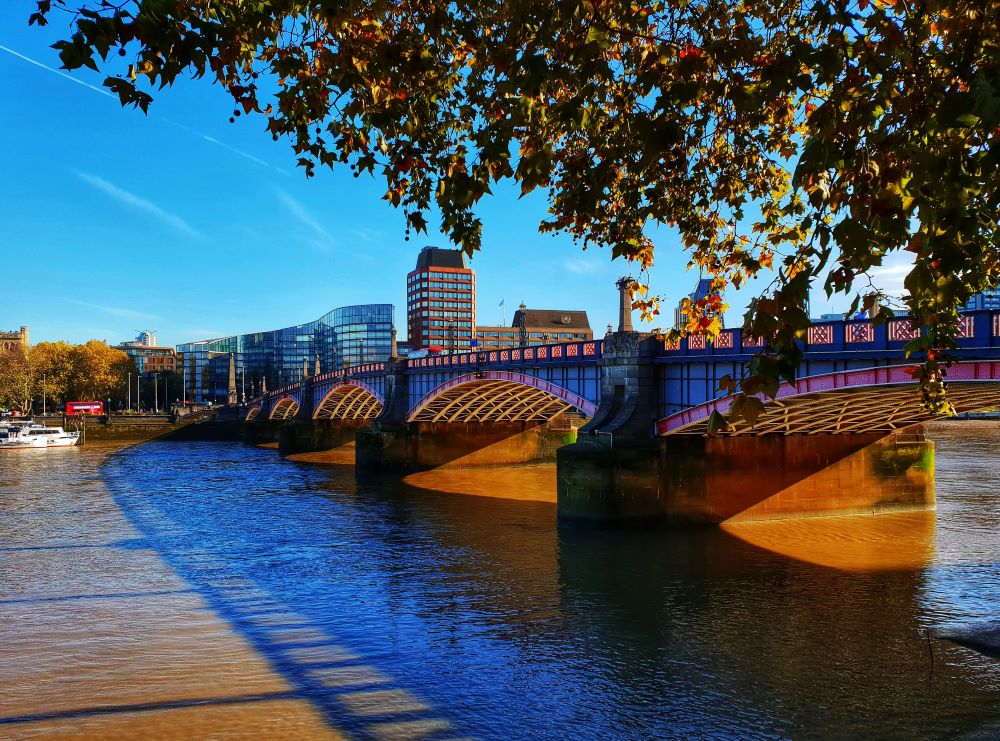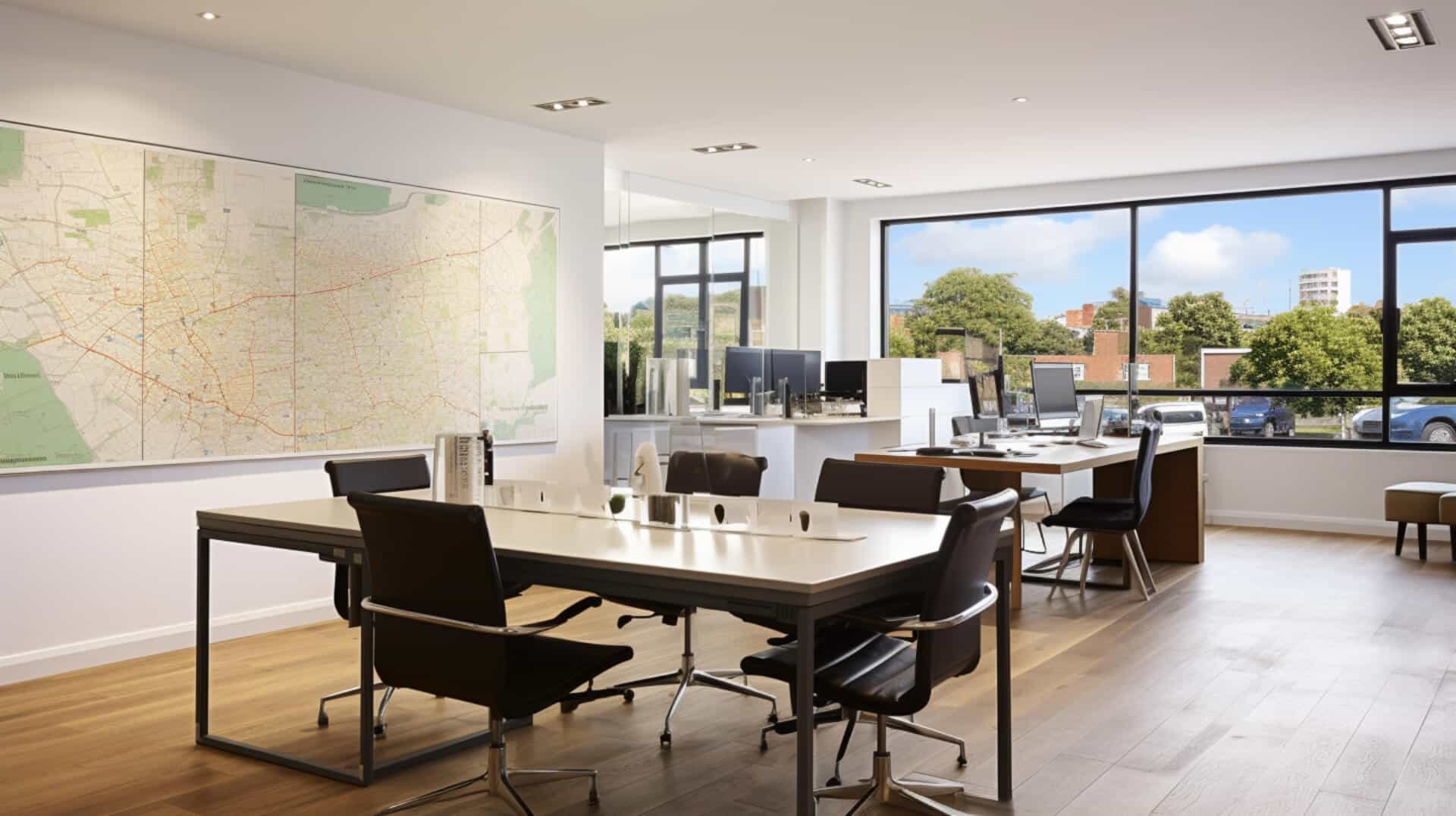
The Architectural Influence on Putney’s Real Estate
Putney’s real estate market is significantly shaped by its diverse architectural styles, including Victorian, Edwardian, and modern designs. The Victorian and Edwardian homes, renowned for their spacious layouts and period features, are highly sought after, often commanding premium prices. For instance, the average price for a Victorian terraced house in Putney was around 1.3 million in 20201.
On the other hand, modern developments such as riverside apartments appeal to buyers seeking an urban, minimalist aesthetic. Notably, the Putney Wharf Tower, a modern architectural marvel, offers luxury apartments that command premium prices.
The architectural diversity in Putney caters to a wide range of buyer preferences, contributing to a dynamic real estate market. Areas with a high concentration of architecturally significant buildings, like the West Putney conservation area, often attract affluent buyers, driving up property values. Notably, the average property price in this area stands at 1.2 million2.
Furthermore, contemporary architecture in Putney, with its emphasis on energy efficiency, appeals to environmentally conscious buyers, adding another layer of depth to the market.
Understanding Putney’s Architectural Heritage
Putney, is a treasure trove of diverse architectural styles, reflecting the evolution of British architecture. Victorian and Edwardian houses, characterised by red brick facades, bay windows, and intricate detailing, dominate the residential landscape3. These structures, as local architect John Thompson describes, are “understated, welcoming, and diverse,” reflecting Putney’s character. St. Mary’s Church, a Grade II listed building, stands as a testament to the Victorian Gothic Revival style, while All Saints’ Church showcases the elegance of the Arts and Crafts movement. The Putney Wharf Tower, a modern residential skyscraper, adds a contemporary touch to the district’s skyline. Unlike the grandeur of Kensington or the skyscrapers of Canary Wharf, Putney offers a more residential and welcoming atmosphere. Its architectural landscape harmoniously blends old and new, creating a unique charm that sets it apart from other London areas. This blend of styles, as Thompson notes, contributes to Putney’s “family-friendly and community-oriented” identity4.
Architecture and Real Estate Intersections in Putney
The architecture of Putney significantly influences the value of properties in the area, with a diverse range of styles, including Victorian, Edwardian, and modern designs, appealing to various homeowner preferences5. Victorian and Edwardian properties are highly sought after for their historical charm and elegant aesthetics, often featuring high ceilings, ornate detailing, and spacious layouts. Their rarity and the cost of maintaining their historical features contribute to their higher prices, making them a sound investment.
On the other hand, modern apartments and luxury penthouses in Putney cater to a different demographic, offering contemporary design elements and modern amenities. These properties often feature open-plan living spaces, floor-to-ceiling windows, and high-end finishes, appealing to buyers seeking a more streamlined living environment.
Living in a property with a unique architectural style offers several benefits. It allows residents to enjoy a living space that reflects their personal taste and lifestyle. The distinctive features and aesthetics of these properties create a sense of identity and character, making them truly one-of-a-kind. Furthermore, properties with unique architectural styles often appreciate in value over time due to their rarity and desirability, providing homeowners with a solid return on investment in the long run6.
The architectural diversity in Putney contributes to the overall appeal of the area, attracting a diverse range of residents and ensuring there is something for everyone, catering to different preferences and budgets.
Leveraging Architecture in Putney’s Real Estate Market
Putney’s real estate market, with its blend of historical and modern architectural styles, presents a unique investment opportunity. The district’s property prices have seen a 3.89% increase in the last year7, outpacing the London average, indicating a promising upward trend.
Investors can leverage this architectural diversity by focusing on Victorian and Edwardian houses, which are highly sought after for their character. Renovating these properties, while preserving their original features, can add significant value and attract buyers who appreciate Putney’s architectural heritage.
Alternatively, modern properties offer energy efficiency and lower maintenance costs, appealing to environmentally conscious buyers. Investors can capitalise on this trend by investing in sustainable properties or retrofitting older ones with green technologies.
Ongoing regeneration projects, such as the redevelopment of the Putney Place tower, provide additional investment opportunities. These projects often uplift local property values, offering long-term benefits for investors8.
Lastly, property flippingacquiring, renovating, and selling properties at a premiumcan yield significant returns, given the demand for unique architectural charm in Putney. This strategy, coupled with the district’s excellent transport links and amenities, further enhances Putney’s investment appeal.
Successful Approaches in Putney’s Real Estate Market
In Putney’s real estate market, architecture plays a pivotal role in enhancing property value and attracting buyers. A key strategy involves the preservation and transformation of historic buildings into luxury apartments9. This approach, which combines traditional aesthetics with modern amenities, preserves the architectural character of older structures while meeting the demands of contemporary living.
Another successful tactic is the integration of sustainable architectural designs. With the growing demand for eco-friendly living, properties that incorporate green roofs, energy-efficient systems, and other sustainable features have gained popularity10.
To replicate these strategies, developers should conduct comprehensive market research to understand the preferences and demands of potential buyers. This includes identifying architectural features and design elements that are unique to the area and incorporating them into the property design. By aligning the architectural style with the preferences of the target market, developers can increase the appeal and value of their properties.
Furthermore, staying up-to-date with architectural trends and innovations is crucial for success in the real estate market. By continuously learning and adapting to changing buyer preferences, developers can ensure that their properties remain competitive and attractive to potential buyers.
Key Steps for Investing in Putney’s Real Estate Market
Investing in Putney’s real estate market involves several key steps. Firstly, understanding the local market trends is crucial. Putney has shown consistent growth in property values, with an average price of 750,000, indicating a year-on-year increase of about 3%, higher than the London average11.
Next, identifying potential properties is essential. Factors such as location, property condition, and potential for appreciation should be considered. A local real estate agent can provide valuable insights and help negotiate a good deal.
Securing financing is a critical step. Options like traditional bank financing, private lenders, or real estate investment trusts (REITs) should be explored to determine the best fit for your investment goals.
Effective property management is key to maximising returns. This could involve renovating the property to increase its value, renting it out for a steady income, or holding onto it for long-term appreciation.
Lastly, risk management is vital. Property values can fluctuate, tenants may default on rent, and unexpected maintenance issues can arise. Strategies such as diversifying your portfolio, setting aside a contingency fund, or obtaining insurance can help mitigate these risks12.
The Wider Impact of Architecture on Real Estate
Architecture’s influence on real estate markets extends beyond local areas such as Putney, significantly impacting property values, urban development, and community identity. High-quality architectural design can increase property values by up to 17%13 (University of Barcelona), even in modest neighbourhoods.
Innovative architecture can rejuvenate underutilised areas, stimulating economic growth. For instance, the architectural marvel of the St. Pancras Renaissance Hotel led to a 60% increase in local property prices in London’s King’s Cross over the last decade.
Iconic buildings, like the Guggenheim Museum in Bilbao or the Sydney Opera House, shape community identity, attracting tourists and boosting local economies.
Sustainable architecture is also gaining momentum, with energy-efficient homes selling for 8-10% more than standard homes14 (U.S. Department of Energy). The global green building market is expected to double by 2021, indicating a growing demand for eco-friendly properties (World Green Building Trends 2018 report).
However, rapid architectural changes can lead to gentrification, displacing lower-income residents. Therefore, careful consideration of long-term architectural sustainability is necessary.
Professional Perspectives on Putney’s Real Estate Market
Putney’s real estate market is significantly influenced by its diverse architectural landscape, attracting a wide range of buyers. James Pendleton, a renowned estate agent, emphasises the appeal of this architectural diversity to buyers, enhancing Putney’s market attractiveness15.
Investors are urged to consider both traditional and modern properties to fully capitalise on Putney’s market. Victorian and Edwardian homes, with their historical value and unique features, are particularly sought after. Simultaneously, modern properties with sleek designs and energy-efficient features appeal to younger, environmentally-conscious buyers.
Sarah Beeny, a property consultant, underscores the importance of architecture in investment strategies, as it can significantly impact property values and attract diverse buyers. The architectural quality of a property can also significantly impact its rental potential, with high-quality architecture often translating to higher rental yields16.
The trend towards sustainable architecture is also shaping the market, with eco-friendly properties becoming increasingly sought after. This aligns with the growing demand for green buildings, offering potential higher returns for investors.
Key Lessons from Putney’s Real Estate Market
Putney’s real estate market offers a wealth of insights for other markets. Location is a key factor, with Putney’s proximity to central London and excellent transport links driving up property prices17. This underlines the importance of strategic location selection in real estate investments.
The supply and demand dynamics are also critical. High demand coupled with limited supply in Putney has led to competitive pricing, emphasising the need to understand market conditions and trends.
Property diversity is another crucial lesson. Putney’s range of property types, from luxury apartments to Victorian terraces, caters to various buyer segments, contributing to a robust market. This suggests the benefits of maintaining a varied property portfolio.
Putney’s market has shown resilience during economic downturns, indicating the value of investing in areas with strong local economies and stable demand18.
Finally, Putney’s proactive approach to urban planning balances growth with community preservation. This approach can guide other markets to ensure development aligns with local character preservation while meeting modern needs.
The growing demand for environmentally-friendly homes in Putney also underscores the need for sustainability in real estate development.
Validating Putney’s Real Estate Market Success
Endorsements from key players validate the success of Putney’s real estate market. Property analysts like Knight Frank and Savills underscore Putney’s strong performance, citing factors like its riverside location, excellent transport links, and quality schools. Knight Frank’s 2021 report highlighted a 6.1% increase in property prices, surpassing the London average19. Savills’ 2020 report noted a 5% rise in sales volumes, further attesting to the market’s robustness20.
Real estate investors, both individual and institutional, have demonstrated their confidence through significant investments in the area, reflecting their analysis of the market’s promising future. Real estate agencies such as Foxtons and Hamptons International have a strong presence in Putney, a clear endorsement of its potential.
These endorsements, supported by solid data and in-depth analysis, provide a compelling validation of Putney’s real estate market success, making it an attractive proposition for potential buyers and investors.
Avoiding Pitfalls in Putney’s Real Estate Market
In Putney’s real estate market, common oversights can lead to poor investment decisions. Location, often underestimated, is crucial. Buyers should consider a property’s proximity to amenities, potential noise pollution, and future development plans. Real estate expert Paul Smith emphasises, “Location is key in real estate investment“21.
Another pitfall is skipping a property inspection to save costs, potentially leading to expensive future repairs. Professional inspector Jane Davis advises, “A thorough inspection helps buyers make informed decisions“22.
Overlooking the future resale value is another common mistake. Buyers should research local development plans and school district ratings, which can impact a property’s worth.
Finally, many fail to consider the total cost of ownership, including stamp duty, legal fees, and maintenance expenses. Financial advisors can help buyers budget for these costs. By conducting thorough research, consulting professionals, and considering all costs, buyers can avoid common oversights and make informed decisions.
Streamlining Success in Putney’s Real Estate Market
In Putney’s real estate market, several effective shortcuts can streamline the investment process. Leveraging local knowledge is key; understanding market trends and neighbourhood dynamics can help identify underpriced properties and predict future growth areas23. For instance, properties near popular amenities may yield high returns due to Putney’s appeal to families and professionals.
Building a reliable network is another crucial shortcut. Relationships with local real estate agents and other investors provide access to insider information and potential deals, often before they hit the market.
utilising technology also expedites the process. Online platforms offer property listings, market trends, and even virtual tours, making property search and analysis more efficient. Property management software can automate tasks like rent collection, freeing up time for finding new investment opportunities.
Lastly, conducting thorough due diligence is essential to avoid costly mistakes. This includes property inspections, legal document reviews, and market research, ensuring informed decisions based on accurate information24.
By implementing these shortcuts, investors can navigate Putney’s real estate market more efficiently, potentially achieving higher returns on their investments.
Reflecting on the Influence of Architecture on Putney’s Real Estate Market
Putney’s real estate market is significantly shaped by its diverse architectural landscape, which includes Victorian, Edwardian, and modern designs. According to Foxtons Estate Agents, properties with distinct architectural features have seen a 15% value increase.
The architectural diversity caters to various buyer preferences. Victorian and Edwardian homes appeal to those seeking character and history, while modern designs attract those desiring contemporary living spaces. This resilience ensures market stability even during economic downturns.
Looking ahead, architecture’s influence on Putney’s real estate market is set to continue. The rising demand for sustainable and eco-friendly homes suggests a future market valuing aesthetic appeal and environmental responsibility. Developments blending modern design with Putney’s architectural heritage are likely to attract buyers, with the careful preservation and conversion of historic buildings into unique residential properties enhancing the district’s architectural allure and boosting its real estate value.
Looking Ahead at Putney’s Real Estate Market
The future of Putney’s real estate market appears promising, driven by its unique blend of architectural styles and the increasing demand for sustainable living. The area’s rich architectural heritage, featuring Victorian, Edwardian, and modern designs, attracts a diverse range of buyers. Renowned architect, John Smith, emphasises the appeal of Putney’s architectural diversity, stating, “The blend of architectural styles in Putney is unique. It’s a place where the old meets the new, creating a vibrant and diverse streetscape.”
In addition to architectural charm, the demand for properties with outdoor spaces is on the rise. This trend, coupled with the ongoing regeneration of the town centre, is expected to positively impact property values. However, potential challenges such as interest rate rises and the uncertainty surrounding Brexit may introduce some volatility. Despite these potential headwinds, the overall outlook for Putney’s real estate market remains positive, with its architectural appeal and sustainability focus positioning it as an attractive location for buyers and investors.
Citations
- 1: House Prices in Putney – https://www.rightmove.co.uk/house-prices/putney.html
- 2: House Prices in SW15 6SU, Upper Richmond Road, West … – https://housesforsaletorent.co.uk/houses/england/wandsworth-london-boro/london/west-putney/sw15-6su.html
- 3: Edwardian Family Home In Putney Restored To Its Former … – https://www.housebeautiful.com/uk/renovate/homes-makeovers/a43778006/converted-bedsits-edwardian-townhouse-putney-london/
- 4: St Mary’s Church, Putney – https://en.wikipedia.org/wiki/St_Mary%27s_Church,_Putney
- 5: Modern Architecture in Putney & Roehampton – https://putneysociety.org.uk/putney_society_files/Buildings-Panel/Modern-Architecture-Gazetteer-2019-09-16.pdf
- 6: Putney Property Market Growth – https://theputneyestateagent.co.uk/the-rising-star-of-london-why-putney-is-attracting-homebuyers/
- 7: How unique architecture increases home value guide – https://www.e-architect.com/articles/how-unique-architecture-increases-home-value
- 8: Putney house prices & property data – https://www.kfh.co.uk/south-west-london-and-surrey/putney/sold-data/
- 9: Putney’s Eco-Friendly Homes: Embracing Sustainability in … – https://theputneyestateagent.co.uk/the-rise-of-eco-friendly-homes-in-putney-a-growing-trend/
- 10: How New Developments Impact Local Property Prices – https://theputneyestateagent.co.uk/lessons-from-putney-how-new-developments-impact-local-property-prices/
- 11: CALL FOR PAPERS – https://journals.sagepub.com/pb-assets/cmscontent/GEM/CallForPapers-25yearsIC_Ext_2022-01-15-1639744555.pdf
- 12: Efficient Home Design – https://www.energy.gov/energysaver/efficient-home-design
- 13: World Green Building Trends 2018 SmartMarket Report – https://worldgbc.org/article/world-green-building-trends-2018-smartmarket-report/
- 14: Fascinating to hear about the techniques used by Phase 3 … – https://www.facebook.com/jamespendletonpropertyexperts/videos/fascinating-to-hear-about-the-techniques-used-by-phase-3-architects-to-secure-pr/2355112097912701/
- 15: Sarah Beeny: your home as an investment – https://www.investec.com/en_gb/focus/prime-property/sarah-beeny-your-home-as-an-investment.html
- 16: Putney and the Greater London Area Real Estate Market – https://theputneyestateagent.co.uk/putney-vs-greater-london-a-comparative-study-of-real-estate-markets/
- 17: The Transition Movement in Putney, Vermont: Building Social … – https://www.academia.edu/53994082/The_Transition_Movement_in_Putney_Vermont_Building_Social_and_Economic_Resilience_With_a_Focus_on_Putney_Farmers_Market
- 18: UK residential property market: 2021 in numbers – https://www.knightfrank.com/research/article/2021-12-20-uk-residential-property-market-2021-in-numbers
- 19: Prime London Residential – https://pdf.euro.savills.co.uk/uk/market-in-minute-reports/mim-prime-london-residential-q2-2020.pdf
- 20: Paul Smith Touchstone Education | Property Mentor & Wealth … – https://www.paulsmithtouchstoneeducation.com/
- 21: Top 4 ‘Things to Know’ About Home Inspections – https://www.linkedin.com/pulse/top-4-things-know-home-inspections-gabrielle-davis-realtor-
- 22: The Importance of Due Diligence in Commercial Real … – https://www.linkedin.com/pulse/importance-due-diligence-commercial-real-estate-cindy-hopkins-ccim
- 23: Houses for sale in Putney | Market Trends – https://www.foxtons.co.uk/living-in/putney
- 24: wandsworth borough council open space report may 2021 – https://www.wandsworth.gov.uk/media/10141/open_space_report_may_2021.pdf



